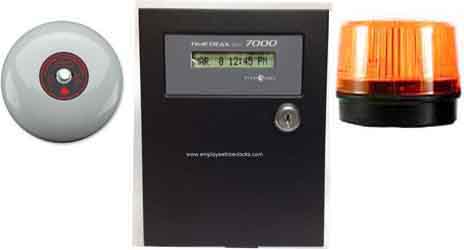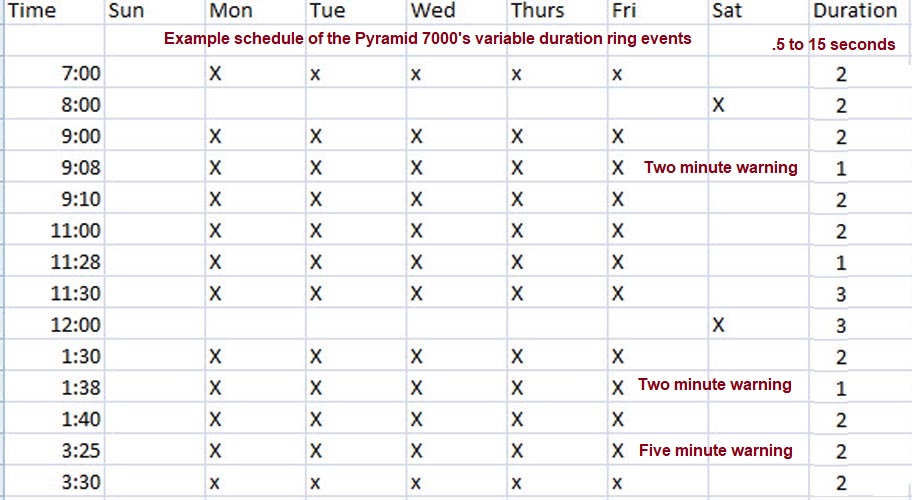Bells and Clocks in a Box grows with you as your business expands!
- 300 ring event capacity, spread across 7 days, with variable ring durations for each shared event.
- 1 Pyramid 7000 synchronized work shift timer with power supply
- Two low voltage Pyramid 95db bells - no conduit is required!
- 25' bell wire - more wire is available, see above list.
Expandable!
- Synchronize up to 300 digital or analog clocks, more with optional power booster.
- Add more bells as you need, up to 35 bells or 20 buzzers.
- Optional synchronized digital clocks are visible up to 250'
Large 4" red numbers on high contrast jet-black background (5" x 11" x 1.5" deep)
Surface mount, requires 110V source at each digital clock
- They are synchronized by a Pyramid BCD time signal data cable from the Pyramid7000 master clock
 or this...
or this...
You can have it all.. bells, strobe lights, clocks.Call us if you have any questions!
It's a 3 button setup, takes 5 minutes.
Just press three buttons to program it, and have your schedule written out and in front of you.
Button one: Enter and Save
Button two: Up (numbers and settings)
Button three: Down (and settings)
Example: Monday through Friday, 1/2 day on Saturday, closed on Sunday:

This has been going on for years: People keep asking "How loud are your bells?"
Unfortunately, it's like describing a dinner at a restaurant. It depends on the environment. Is it an empty room like a gymnasium? Does it have lots of rooms, or lots of background noise like a woodworking shop? Is this a warehouse with lots of rows of shelving and boxes of fabric?
Bells and buzzers all seem to max out at 102db. 102db is very loud.
110db is extremely loud. Painfully loud. Ear-ringing loud.
In our experience, installing 2 to 3 bells or buzzers is much more effective than just one. Put one by the timer, then run wire out the another, half-way across the building, or 100'. It won't be louder, it will just be more likely to be heard above all the background noise.
So, yours truly did some research recently (2016), this is interesting:
Using an Android phone decibel app, this is what we found:
**A bedroom at night in the country, windows closed: 28 - 32 db
**A bedroom at night in the city with the windows closed: 42- 46 db
**Office environment, people chattering: 62db
**American Airlines 737 inside just behind the wing,
where you can see the engine: during takeoff 86db
**Same jet, landing with the reverse thrusters on: 88db That ROAR you hear..
**Same jet, cruising for 3 hours, it's 82 to 86db. That's partially why flying is tiring.
Shop buzzer's: 102db (Edwards, the ones we sell) Other brands "hum" at 82 to 86.
Our bells test out at 98 to 103db depending on voltage When you fly, put napkins in your ears, you will arrive much less "buzzed."
It seems that no one offers anything louder than 102db, unless it goes on a train, ocean liner, or fog horn. In some cases loudspeakers are used on farms; we don't have them, but our equipment will ring them. This is 110db, a train horn on an obnoxious person's pickup truck. In a working environment, this would clearly cause accidents.
https://www.youtube.com/watch?v=TiWNw0A1Ijg&feature=related
More bells or horns does not make it louder, it just makes it more pervasive - easier to hear through the machinery, across the rooms, over the land.
July 5, 2018 more to know:
A Fire Station Siren is 106 decibals. Our bells and buzzers are typically 98 to 102.
Pays for itself IN JUST ONE WEEK:
Example:
You are in manufacturing, you have 10 or more employees at $25 per hour
They drag out break and lunch time by 2 to 3 minutes, every day, two breaks, one lunch a day. Worse yet, you have "smokers.
When the lunch ends, someone has to shout "Back to work!" Yes, this sucks.
Stop the drama, the bell becomes "the bad guy." Not Mike, the shop foreman.
Install a simple - or advanced - bell or buzzer system, the bell becomes that "bad guy."
They won't miss a break, they will take lunch on time, they will start when they should, they will come back, like trained people, when they are supposed to.
You will collect back, using very conservative numbers, a minimum of 4 minutes per day per person.
If it doesn't sound like much, you would be wrong.
Using conservative numbers, the math won't lie:
1 employee, $25 per hour WITH taxes and benefits. (You're really paying about $30 up front, you can't avoid the taxes, PTO, insurances):
That's 42 to 50 cents labor cost, one employee, per minute. We will work with 42 cents/minute.
Recover 1 minute of break time. 2 minutes of lunch time. 1 more minute of second break.
Remember, they then work until the END OF DAY with the bell system, not relaxing 15 minutes ahead of time. That's additional labor expenses you will recover.
We can count on 4 minutes absolute minimum time recovered, per man, per day. 4x.34=$1.68 per day. 5 days: $8.40 per week per worker. 10 employees = 84.00/weekly
52 weeks: $4,368 per year per employee in recovered labor time. Every year.
$4,368 x 10 employees. $ 43,638 recovered work time. Every year.
And the shop becomes more organized.
Add a digital clock so that they all know exactly what time it is, and it gets even better.